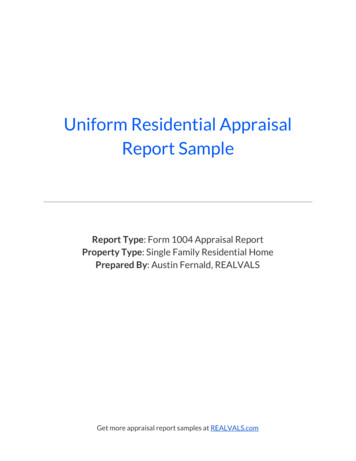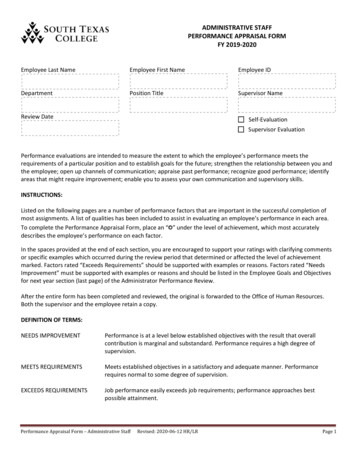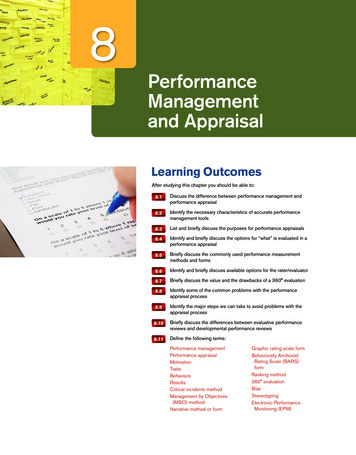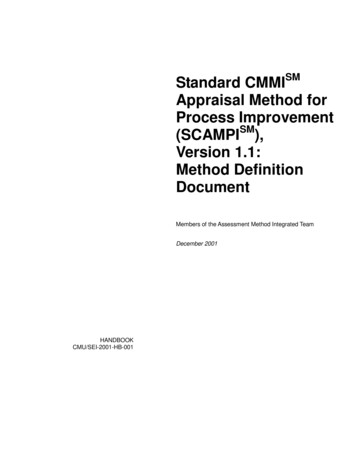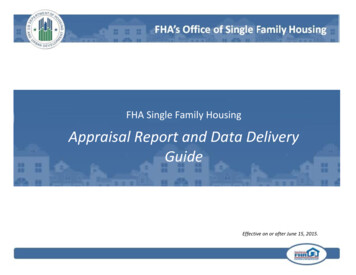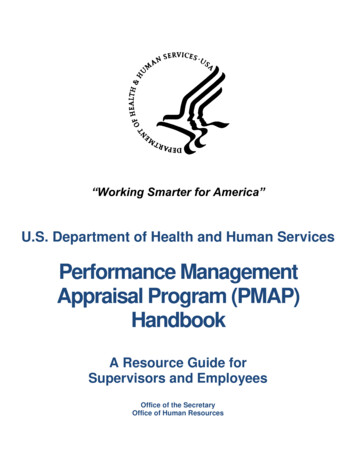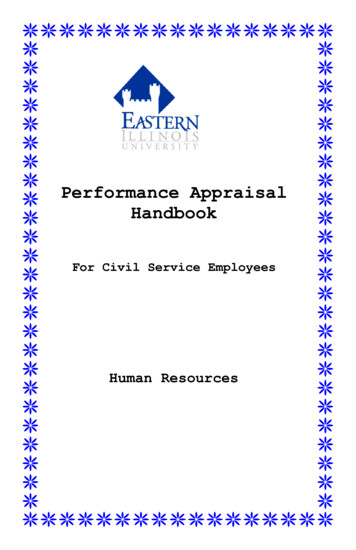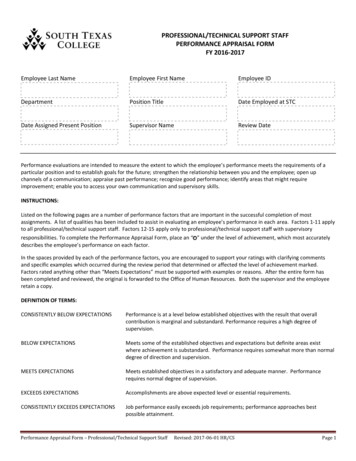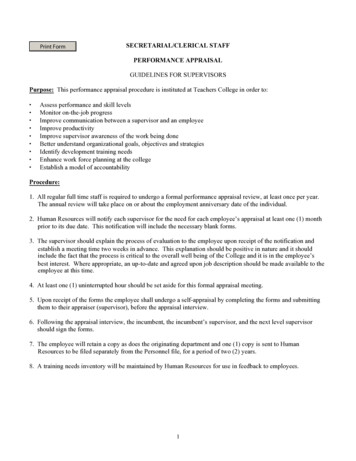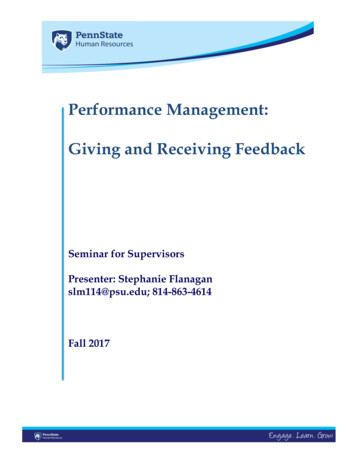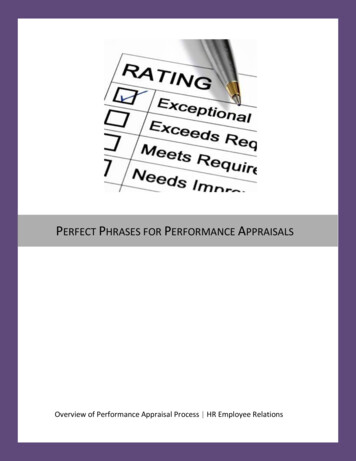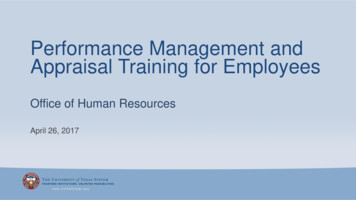
Transcription
Performance Management andAppraisal Training for EmployeesOffice of Human ResourcesApril 26, 2017
Training Objectives Identify the benefits of performancemanagement Review the performance appraisalframework and timelines. Provide a guided walkthrough ofPerformancePro. Introduce future Performance Managementenhancements.2
What is Performance Management?By definition, performance management is an ongoingprocess of communication between a supervisor and anemployee that occurs throughout the year, in support ofaccomplishing the strategic objectives of theorganization.3
How Performance Management Makes aBusiness ImpactEnsures that employees’ work isfocused on the right areas to drive oursuccessReinforces a performance-based modelwhere exceptional performance is highlyrewarded and best performers areidentifiedEffective PerformanceManagementFosters employee engagementMaximizes work efficiency4
What is a Performance Appraisal?By definition, a performance appraisal is a formal recordof a supervisor’s assessment of the quality of anemployee’s work performance.5
When done well, a performance appraisal Reinforces the value of the employee’s workIs balanced, objective, and informativeProvides specifics about what went well, and whatareas to tackle for improvementContributes to the future success of the organizationEngages manager and employee in developing acareer planCreates an environment for collaboration and opencommunicationProvides a record/foundation for merit increases– State law requires institutions to establish criteriafor awarding merit increases6
UT System Administration Appraisal FrameworkSelfappraisalby May10thTo better align our performance management andbudget processes, we are moving our appraisalcompletion deadline up to May 26th.AppraisalReviewComplete by:May 26thManagerappraisalApplies to: Benefits eligible Classified andA&P employees with a startdate* prior to 3/1 (merit eligible) Appraisal review period: June1, 2016 to May 31, 2017*Employees with a start date 3/2 or later will complete a 90 or 180-day appraisal (not merit eligible)7
Writing Your Self-AppraisalDo:- Use specific and relevantexamples- Be factual and objective- Clearly express successes- Identify areas for growth- Balance review of the previousyear with forward-lookingcommentsDon’t:- Generalize- Use absolute words such as“always, never, completely, etc.”- Commit in writing what you cannot deliver- Harp on your weaknesses- Be defensive or criticize others.8
Self-appraisal Example Comments“I reviewed our IT vendor contract and realized that we were not being given the preferredcustomer rate we were promised. I contacted the vendor and negotiated a steeper discount,saving the department 15,000 over the course of a year."“This past year, I really worked on improving my teamwork skills. After completing the 2-dayTeamwork 101 course, I had a much better understanding of team dynamics and how tocontribute more effectively in the various roles and stages of team development.”“I served on 3 key teams this past year: the corporate social responsibility committee, thecustomer service process improvement team and the team involved in successfully completingcritical orders for our customer Dunrite.”9
Performance Factors: Non-SupervisorPerformance FactorWeightAccomplishments: Work Plan, Goals, Duties and Responsibilities/ OtherAccomplishments40%Accountability: Quality Reliability Compliance20%Knowledge, Skills, and Abilities Communication Job Knowledge Teamwork20%Commitment to Excellence Initiative & Innovation Customer Service Mission Support20%10
Performance Factors: Supervisor/Senior StaffPerformance FactorWeightAccomplishments: Work Plan, Goals, Duties and Responsibilities/ OtherAccomplishments40%Accountability: Focus on Results Quality Reliability Compliance20%Knowledge, Skills, and Abilities Communication Job Knowledge Teamwork20%Management Initiative & Innovation Planning & Resource Stewardship Leadership Identify, Hire, Develop, & Retain20%11
Rating ScaleUT System uses a five-point rating scale for factors and overall performance: Outstanding Performance Very Good Performance Meets job expectations and requirements and may occasionally exceed performance objectives.Needs Improvement Exceeded the expectations and requirements of the assigned position and regularly produces expectedaccomplishments in all areas of responsibility.Good Performance Exemplary accomplishments throughout the rating period and/or represented by unique and unusualaccomplishments and result in specifically identifiable or quantifiable benefit to System Administration or theinstitutions.May meet some of the job expectations but does not fully meet the remainder.Unsatisfactory Performance Fails to meet defined expectations and minimum job requirements.12
Goal EvaluationThis step is only applicable if goals were entered in 2016. Evaluate current goals during this appraisal process. As an enhancement to the Performance Management process, HR will be holding leadership goalsessions to move to a focus on performance goal outcomes. Once organizational and departmental goals are established, they will be communicated to allemployees through a Goal Setting Process.As a result, no future goals will be added during the May appraisal process.Future goals will be created and documented in the upcoming months.13
Future Goals Coming Soon14
PerformancePro Appraisal Quick OverviewBegin the process by:–––Logging into Performance Pro Using SNACSingle sign-onSet to Employee Role3 Primary Evaluation Steps–––Evaluate FactorsEvaluate Current Assigned Goals (applicable only if goals were previously created in 2016)Complete Summary Comments (Summarize the Evaluation Period)Routing Steps to Complete/E-Sign––Mark Ready: Indicates you are done with your first draft.E-Sign: Both Employee and Appraiser will E-Sign the Appraisal.15
PerformancePro1.2.3.4.5.Access UT4U http://www.utsystem.edu/ut4u/homepage.htmNavigate to Resources/Current Employees/Performance ManagementSelect the University of Texas System Administration as your home institutionEnter your SNAC login and passwordPress Submit16
Step 1: Evaluate FactorsFrom the Home Toolbar, click on the Appraisal Menu, then select Evaluate Factors. Select a factor toevaluate from the Overview tab.133217
Step 1: Evaluate Factors (continued)Under the Evaluation tab select the factor to evaluate. Next, select a rating for the factor. Entercomments. Repeat this step for each factor.11223318
Step 2: Evaluate Current Goals (if applicable)Under the Appraisal menu, click Evaluate Goals. Next, select a rating for the goal. Enter comments.Repeat this step for each goal.12213319
Step 2: Evaluate Goals (continued)View prior to evaluating on the overview tabView after goal has been evaluated.20
Step 3: Summary Comments and Ready for MeetingFrom the Home Toolbar, under Appraisals, click Summary Comments. Click in the SummaryComments box and enter any additional information, concerns, etc. (if desired).1221
Step 4: Summary Comments and Ready for Meeting (continued)WARNING: THIS IS YOUR LAST CHANCE TO MAKE CHANGES.Once you mark the appraisal as ready you may not change it.1222
Step 5: Email Notification – PerformanceProE-sign23
Step 6: E-Signing the AppraisalClick on the Checkbox, select Agree or Disagree. Then Save.123YOU HAVE COMPLETED YOUR SELF-APPRAISAL!24
Viewing Your Current AppraisalFrom the Main Menu, click Home. Click My Current Appraisal. You may view your assigned factors,goals and your self-appraisal scores. Completed appraisals, which include the appraiser’s scores,cannot be viewed from this screen.25
Employee Self AppraisalBy May 26thStep 1: Review NotesStep 6:Sign the AppraisalStep 2:EvaluateFactorsStep 3:EvaluateGoalsStep 4:Ready forMeetingMeetingStep 3:EvaluateGoalsAppraiserStep 2:EvaluateFactorsStep 4:Ready forMeetingStep 7:Complete theAppraisalStep 5:MergeAppraisalEdit Appraisal, ifnecessaryStep 1:Review NotesStep 8:Sign the Appraisal26
We heard you, and we’re making changes toimprove the Performance Management process. Transition from performance factors to Leadership CompetenciesReplacing Performance Appraisals with a new Performance Goal processSimplified weighting systemA focus on performance goal outcomes, not activitiesFeedback from peers and/or indirect managersOngoing performance discussions and teachable momentsIntroduce Pay for PerformanceSystems enhancements coming 27
Resources UT System UT4U Performance Management Site– FAQs– PowerPoint Slides– Quickstart Guide– Factor Weight and Definition Guide OES SharePoint– Recorded Presentations (Video/Audio) HR Business Partner28
HR Business Partner TeamSiria Barrera, MA, SHRM-SCPHR Business PartnerJulio Arizmendi, MPAHR Business PartnerDEPARTMENTSBOARD OF REGENTSFEDERAL RELATIONSGOVERNMENTAL RELATIONSHEALTH AFFAIRSHUBHUMAN RESOURCESINNOVATION & STRATEGICINVESTMENTOGCPOLICE (ODOP)SHARED SERVICESSTRATEGIC INITIATIVESTMD-SASDEPARTMENTSBUSINESS AFFAIRSBUSINESS DEVELOPMENTCONTRACTS AND PROCUREMENTCONTROLLER'S OFFICEEMPLOYEE BENEFITS (OEB)FINANCEOTISINFORMATION SECURITYRISK MANAGEMENT (ORM)SHARED BUSINESS OPS (SBO)SYS-WIDE INFO SVCS (SWIS)SYSTEMWIDE COMPLIANCETOGIDEPARTMENTSACADEMIC AFFAIRSCHANCELLOR'S OFFICEEXTERNAL RELATIONSFACILITIES (OFM)Johnny Reyes, SHRM-SCPHR Business PartnerOFPCDEPARTMENTSAUDITINST FOR TRANS LEARN(ITL)SHARED INFORMATIONSERVICES (SIS)Stephanie Gil, PHR, SHRM-CPManager, HRBP TeamUNIVERSITY LANDS29
30
appraisal by May 10th Manager appraisal Appraisal Review Complete by: May 26th Applies to: Benefits eligible Classified and A&P employees with a start date* prior to 3/1 (merit eligible) Appraisal review period: June 1, 2016 to May 31, 2017 *Employees with a start date 3/2 or later will complete
